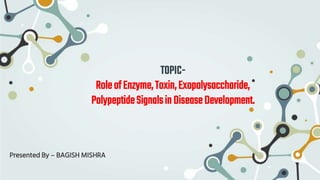
Role of enzyme in plant disease
- 1. TOPIC- RoleofEnzyme,Toxin,Exopolysaccharide, PolypeptideSignalsin DiseaseDevelopment. Presented By – BAGISH MISHRA
- 2. FLOWOFPRESENTION • INTRODUCTION • Enzyme • Enzyme-Hydrolases • Enzyme- Hemicelluloses • Enzyme-Proteolytic • Toxins • Type Of Toxin • Exopolysaccharides • Polypeptide Signals in Disease Development. 02
- 3. INTRODUCTION The diseases caused by pathogens on plants are the result of biochemical reactions that takes place between substances secreted by the casual agents and those present within the plants. The activities of pathogens in plants are mostly chemical in nature. The substances secreted by plants are responsible for causing the disease either directly or indirectly. These substances are enzymes, toxins, growth regulators, polysaccharides and antibiotics. These groups of chemical substances vary in pathogenicity Enzymes, toxins and growth regulators are common and most important in development of plant disease.
- 4. Enzyme Plant pathogenic enzymes disintegrate the host cells; break food substances present in the cell and interfere with its functioning systems. Enzymes secreted by microorganism play a key role in disease development. These break down plant substances into smaller molecules which pathogen easily absorb and utilize for its growth and energy.
- 5. Enzyme-Hydrolases Hydrolases is most important enzymes involved in the production of disease by plant pathogens. Complete plant tissue disintegration involves break down of lignin. Pectin which is the main component of middle lamella is polysaccharides are known to degrade by several enzymes. Cellulose degrading enzymes are produced by several phytopathogenic fungi, bacteria and nematodes. In living plants tissues, cellulytic enzymes secreted by pathogens play a role in the softening and disintegration of the cellulose cell walls.
- 6. Enzyme-Hemicelluloses Hemicelluloses an integral part of cell wall are mixture of water insoluble polysaccharides and lignin of plant cell walls. Hemicelluloses disintegrate these hemicelluloses. Lignin found in middle lamella, in cell wall of xylem vessels, in fibres; in epidermal and hypodermal cell .Ligninase degrade lignin. Enormous amounts of lignin are degraded by microorganisms in nature. Brown rot fungi and white rot fungi are capable of degrading lignin
- 7. Enzyme-Proteolytic Proteolytic enzymes catalyze the hydrolysis of peptide linkages. The degradation of host proteins by proteolytic enzymes secreted by pathogens affects the organizayion and function of the host cell. Starch is polysaccharides found cell is synthesized in chloroplast and amyloplast. Most pathogens utilized starch and other polysaccharides, in their metabolic activities. The degradation of starch is brought about by the action two enzymes α- amylaseamylase and β-amylase amylase. Isoamylase is also responsible for degradation of starch. Many fungi, bacteria, nematodes are capable of degrading lipid. Lipolytic enzymes like lipases, phospholipidases etc. hydrolyze the liberation of fatty acids from the lipid molecules. Fatty Acid is directly utilized by the pathogen.
- 8. Toxins Living plant cells are complex bodies in which many independent biological reactions take place. Metabolic reaction disrupts the physiological processes that lead to development of plant disease. The factors which disrupts are metabolites are Toxins which directly act on living host protoplast and kill the cells of the plant. During host pathogen reaction certain chemical substances are produced by pathogen which are responsible for disease symptoms in plant. These chemical substances are called toxins. Fungi and bacteria may produce toxins in infected plants and as well in culture media
- 9. TypeOfToxin Phytotoxins: - Produce by fungi or higher plants. 1. Pathotoxins: - These are able to produce in susceptible host plants. All characteristic disease symptoms but have little or no effect on resistance species. 2. Vivotoxins: - Produce protion of disease symptoms. Endotoxins: - Intercellular toxins. Formed in bacterial cells and not liberated until the latter die. Exotoxins:- Extracellular toxins which diffuse from living bacterial cell.
- 10. TypeOfToxin Pleiototropic toxins: - Toxins produced by plant pathogens having multiple effects on host cells. Monotropic toxins: - Produce by bacteria which attack animals. This is unstable toxins. Marasims or wilting toxins: - cause loss of cell turgor and leaf flaccidity. Necrotoxins: - Cause necrosis. Zootoxins: - Produce by animals.
- 11. Exopolysaccharides Water retention Hydrophilic exopolysaccharides have high water retention ability thus maintaining a hydrated microenvironment around biofilm and this leading to the survival of desiccation in water- deficient environments. Cohesion of biofilms Neutral and charged exopolysaccharides forms a hydrated polymer network (the biofilm matrix), mediating the mechanical stability of biofilms (often in conjunction with multivalent cations), determining biofilm architecture, as well as allowing cell-cell communication. Nutrient source Exopolysaccharides serves as source of carbon, nitrogen and phosphorus containing compounds for utilization by the biofilm community. Protective barrier Exopolysaccharides confers resistance to non specific and specific host defences during infection, confers tolerance to various antimicrobial agents, protects cyanobacterial nitrogenase from the harmful effects of oxygen and offers protection against some phagocytic protozoa.
- 12. PolypeptideSignalsinDisease Development. Insect and pathogen attacks activate plant defense genes within minutes in nearby cells, and within hours in leaves far distant from the sites of the predator attacks. A search for signal molecules involved in both the localized and distal signalling has resulted in the identification of an 18-amino-acid polypeptide, called systemin, that activates defense genes in leaves of tomato plants when supplied at levels as low as fmols /plant. Several lines of evidence support a role for systemin as a wound hormone. As with animal polypeptide hormones, systemin is derived from a larger precursor protein, called prosystemin, by limited proteolysis. Systemin has been shown by autoradiography to be phloemmobile and, by antisense technology, to be an essential component of the wound-inducible, systemic signal
- 13. PolypeptideSignalsinDisease Development. . A search for the receptor of systemin has led to the identification in plant plasma membranes of a systemin-binding protein. However, this protein has properties not of a receptor, but of a furin- like proteinase that cleaves systemin into smaller polypeptides. Systemin and its precursor prosystemin provide prototypes for the emerging possibilities that polypeptide hormones may have broad roles in signalling environmental stress responses, and in regulating plant growth and development as well.
- 16. THANKYOU